Leadership and Project Management: Risk, Quality, and People Analysis
VerifiedAdded on 2023/06/10
|13
|3394
|120
Report
AI Summary
This report examines leadership and the management of project risk, quality, and people, using a case study of an electrical engineering firm, Dag-Bruken. It identifies and analyzes three key risks: strategy and technological risks, the environment in which processes are managed, and software development risks. For each risk, the report provides justification for its impact, probability ratings, potential mitigation strategies, and contingency plans with budgetary implications. The report also explores two techniques for risk analysis, including Pareto analysis, and discusses their relevance within the risk management life cycle. The analysis highlights the importance of leadership in addressing these risks and ensuring successful project outcomes, emphasizing the need for proactive planning, effective mitigation strategies, and contingency measures to minimize potential negative impacts on business performance. The report provides a comprehensive overview of project risk management, offering valuable insights for students and professionals alike.
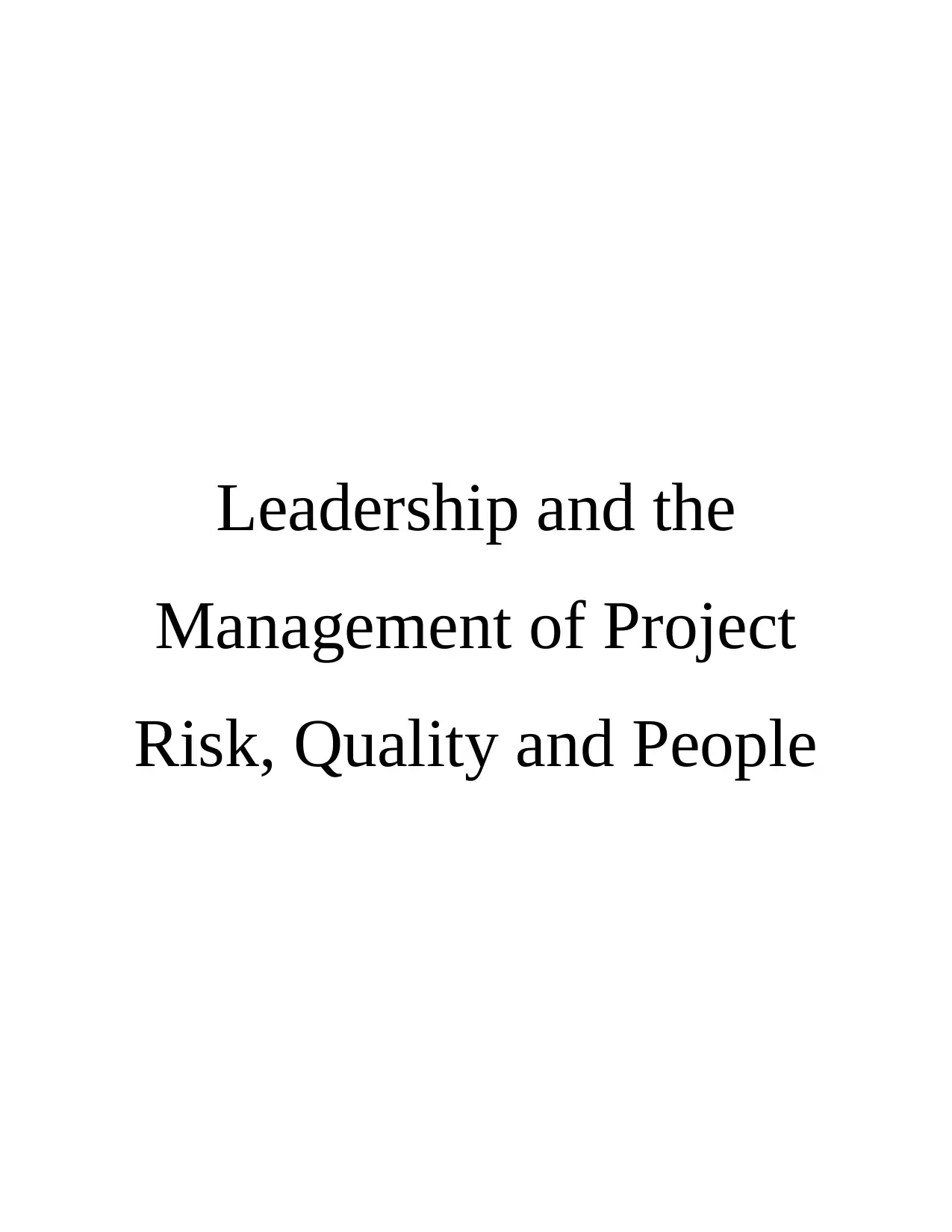
Leadership and the
Management of Project
Risk, Quality and People
Management of Project
Risk, Quality and People
Paraphrase This Document
Need a fresh take? Get an instant paraphrase of this document with our AI Paraphraser
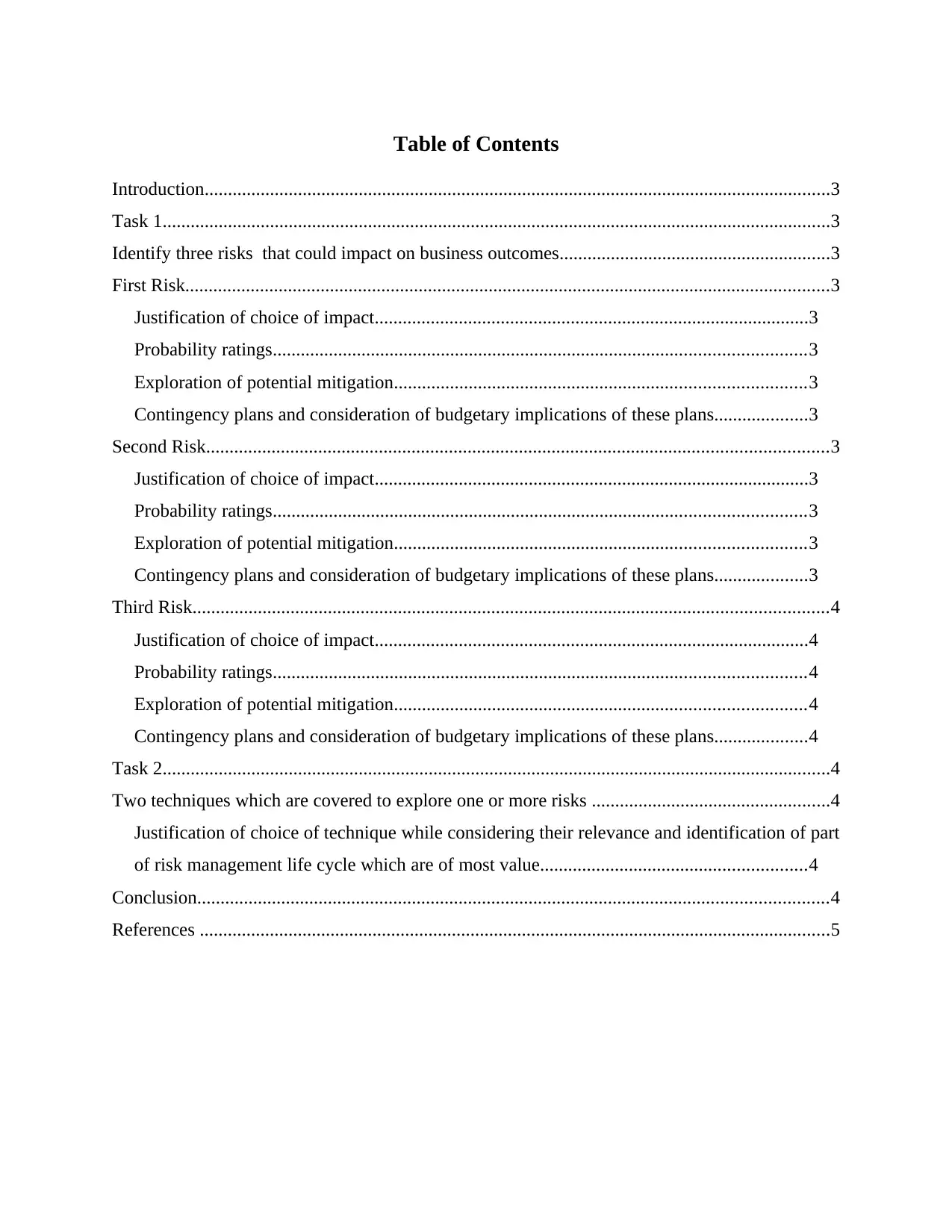
Table of Contents
Introduction......................................................................................................................................3
Task 1...............................................................................................................................................3
Identify three risks that could impact on business outcomes..........................................................3
First Risk..........................................................................................................................................3
Justification of choice of impact.............................................................................................3
Probability ratings..................................................................................................................3
Exploration of potential mitigation........................................................................................3
Contingency plans and consideration of budgetary implications of these plans....................3
Second Risk.....................................................................................................................................3
Justification of choice of impact.............................................................................................3
Probability ratings..................................................................................................................3
Exploration of potential mitigation........................................................................................3
Contingency plans and consideration of budgetary implications of these plans....................3
Third Risk........................................................................................................................................4
Justification of choice of impact.............................................................................................4
Probability ratings..................................................................................................................4
Exploration of potential mitigation........................................................................................4
Contingency plans and consideration of budgetary implications of these plans....................4
Task 2...............................................................................................................................................4
Two techniques which are covered to explore one or more risks ...................................................4
Justification of choice of technique while considering their relevance and identification of part
of risk management life cycle which are of most value.........................................................4
Conclusion.......................................................................................................................................4
References .......................................................................................................................................5
Introduction......................................................................................................................................3
Task 1...............................................................................................................................................3
Identify three risks that could impact on business outcomes..........................................................3
First Risk..........................................................................................................................................3
Justification of choice of impact.............................................................................................3
Probability ratings..................................................................................................................3
Exploration of potential mitigation........................................................................................3
Contingency plans and consideration of budgetary implications of these plans....................3
Second Risk.....................................................................................................................................3
Justification of choice of impact.............................................................................................3
Probability ratings..................................................................................................................3
Exploration of potential mitigation........................................................................................3
Contingency plans and consideration of budgetary implications of these plans....................3
Third Risk........................................................................................................................................4
Justification of choice of impact.............................................................................................4
Probability ratings..................................................................................................................4
Exploration of potential mitigation........................................................................................4
Contingency plans and consideration of budgetary implications of these plans....................4
Task 2...............................................................................................................................................4
Two techniques which are covered to explore one or more risks ...................................................4
Justification of choice of technique while considering their relevance and identification of part
of risk management life cycle which are of most value.........................................................4
Conclusion.......................................................................................................................................4
References .......................................................................................................................................5
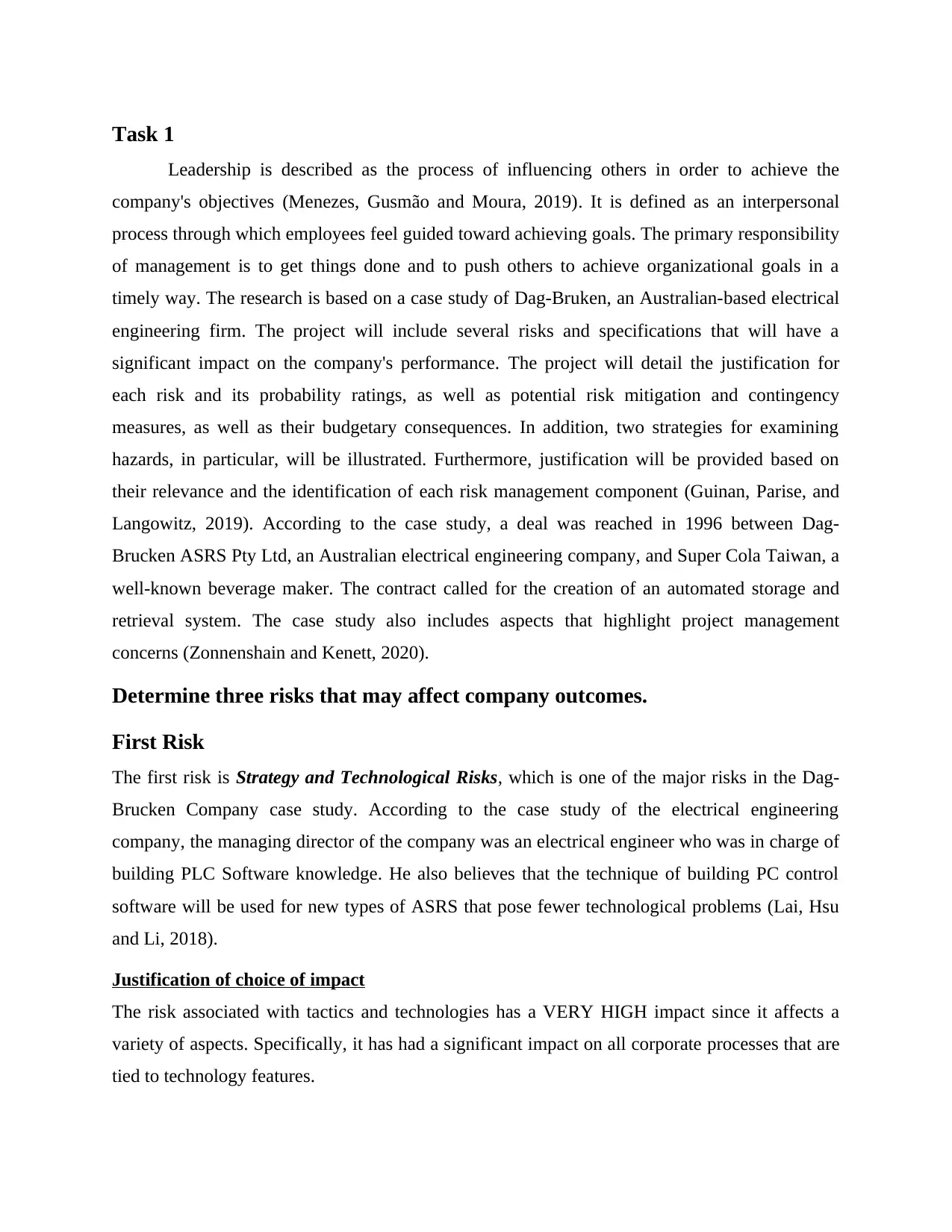
Task 1
Leadership is described as the process of influencing others in order to achieve the
company's objectives (Menezes, Gusmão and Moura, 2019). It is defined as an interpersonal
process through which employees feel guided toward achieving goals. The primary responsibility
of management is to get things done and to push others to achieve organizational goals in a
timely way. The research is based on a case study of Dag-Bruken, an Australian-based electrical
engineering firm. The project will include several risks and specifications that will have a
significant impact on the company's performance. The project will detail the justification for
each risk and its probability ratings, as well as potential risk mitigation and contingency
measures, as well as their budgetary consequences. In addition, two strategies for examining
hazards, in particular, will be illustrated. Furthermore, justification will be provided based on
their relevance and the identification of each risk management component (Guinan, Parise, and
Langowitz, 2019). According to the case study, a deal was reached in 1996 between Dag-
Brucken ASRS Pty Ltd, an Australian electrical engineering company, and Super Cola Taiwan, a
well-known beverage maker. The contract called for the creation of an automated storage and
retrieval system. The case study also includes aspects that highlight project management
concerns (Zonnenshain and Kenett, 2020).
Determine three risks that may affect company outcomes.
First Risk
The first risk is Strategy and Technological Risks, which is one of the major risks in the Dag-
Brucken Company case study. According to the case study of the electrical engineering
company, the managing director of the company was an electrical engineer who was in charge of
building PLC Software knowledge. He also believes that the technique of building PC control
software will be used for new types of ASRS that pose fewer technological problems (Lai, Hsu
and Li, 2018).
Justification of choice of impact
The risk associated with tactics and technologies has a VERY HIGH impact since it affects a
variety of aspects. Specifically, it has had a significant impact on all corporate processes that are
tied to technology features.
Leadership is described as the process of influencing others in order to achieve the
company's objectives (Menezes, Gusmão and Moura, 2019). It is defined as an interpersonal
process through which employees feel guided toward achieving goals. The primary responsibility
of management is to get things done and to push others to achieve organizational goals in a
timely way. The research is based on a case study of Dag-Bruken, an Australian-based electrical
engineering firm. The project will include several risks and specifications that will have a
significant impact on the company's performance. The project will detail the justification for
each risk and its probability ratings, as well as potential risk mitigation and contingency
measures, as well as their budgetary consequences. In addition, two strategies for examining
hazards, in particular, will be illustrated. Furthermore, justification will be provided based on
their relevance and the identification of each risk management component (Guinan, Parise, and
Langowitz, 2019). According to the case study, a deal was reached in 1996 between Dag-
Brucken ASRS Pty Ltd, an Australian electrical engineering company, and Super Cola Taiwan, a
well-known beverage maker. The contract called for the creation of an automated storage and
retrieval system. The case study also includes aspects that highlight project management
concerns (Zonnenshain and Kenett, 2020).
Determine three risks that may affect company outcomes.
First Risk
The first risk is Strategy and Technological Risks, which is one of the major risks in the Dag-
Brucken Company case study. According to the case study of the electrical engineering
company, the managing director of the company was an electrical engineer who was in charge of
building PLC Software knowledge. He also believes that the technique of building PC control
software will be used for new types of ASRS that pose fewer technological problems (Lai, Hsu
and Li, 2018).
Justification of choice of impact
The risk associated with tactics and technologies has a VERY HIGH impact since it affects a
variety of aspects. Specifically, it has had a significant impact on all corporate processes that are
tied to technology features.
⊘ This is a preview!⊘
Do you want full access?
Subscribe today to unlock all pages.

Trusted by 1+ million students worldwide
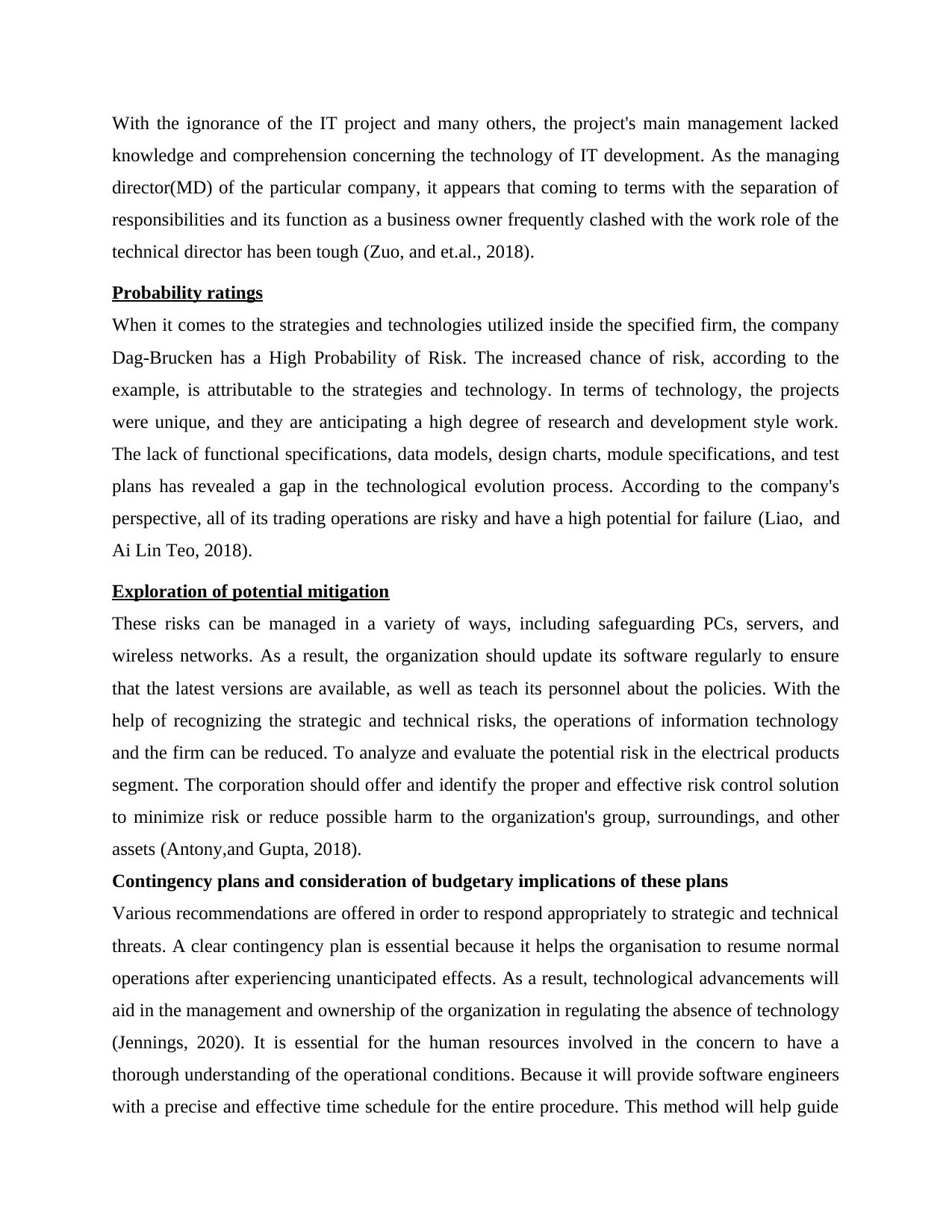
With the ignorance of the IT project and many others, the project's main management lacked
knowledge and comprehension concerning the technology of IT development. As the managing
director(MD) of the particular company, it appears that coming to terms with the separation of
responsibilities and its function as a business owner frequently clashed with the work role of the
technical director has been tough (Zuo, and et.al., 2018).
Probability ratings
When it comes to the strategies and technologies utilized inside the specified firm, the company
Dag-Brucken has a High Probability of Risk. The increased chance of risk, according to the
example, is attributable to the strategies and technology. In terms of technology, the projects
were unique, and they are anticipating a high degree of research and development style work.
The lack of functional specifications, data models, design charts, module specifications, and test
plans has revealed a gap in the technological evolution process. According to the company's
perspective, all of its trading operations are risky and have a high potential for failure (Liao, and
Ai Lin Teo, 2018).
Exploration of potential mitigation
These risks can be managed in a variety of ways, including safeguarding PCs, servers, and
wireless networks. As a result, the organization should update its software regularly to ensure
that the latest versions are available, as well as teach its personnel about the policies. With the
help of recognizing the strategic and technical risks, the operations of information technology
and the firm can be reduced. To analyze and evaluate the potential risk in the electrical products
segment. The corporation should offer and identify the proper and effective risk control solution
to minimize risk or reduce possible harm to the organization's group, surroundings, and other
assets (Antony,and Gupta, 2018).
Contingency plans and consideration of budgetary implications of these plans
Various recommendations are offered in order to respond appropriately to strategic and technical
threats. A clear contingency plan is essential because it helps the organisation to resume normal
operations after experiencing unanticipated effects. As a result, technological advancements will
aid in the management and ownership of the organization in regulating the absence of technology
(Jennings, 2020). It is essential for the human resources involved in the concern to have a
thorough understanding of the operational conditions. Because it will provide software engineers
with a precise and effective time schedule for the entire procedure. This method will help guide
knowledge and comprehension concerning the technology of IT development. As the managing
director(MD) of the particular company, it appears that coming to terms with the separation of
responsibilities and its function as a business owner frequently clashed with the work role of the
technical director has been tough (Zuo, and et.al., 2018).
Probability ratings
When it comes to the strategies and technologies utilized inside the specified firm, the company
Dag-Brucken has a High Probability of Risk. The increased chance of risk, according to the
example, is attributable to the strategies and technology. In terms of technology, the projects
were unique, and they are anticipating a high degree of research and development style work.
The lack of functional specifications, data models, design charts, module specifications, and test
plans has revealed a gap in the technological evolution process. According to the company's
perspective, all of its trading operations are risky and have a high potential for failure (Liao, and
Ai Lin Teo, 2018).
Exploration of potential mitigation
These risks can be managed in a variety of ways, including safeguarding PCs, servers, and
wireless networks. As a result, the organization should update its software regularly to ensure
that the latest versions are available, as well as teach its personnel about the policies. With the
help of recognizing the strategic and technical risks, the operations of information technology
and the firm can be reduced. To analyze and evaluate the potential risk in the electrical products
segment. The corporation should offer and identify the proper and effective risk control solution
to minimize risk or reduce possible harm to the organization's group, surroundings, and other
assets (Antony,and Gupta, 2018).
Contingency plans and consideration of budgetary implications of these plans
Various recommendations are offered in order to respond appropriately to strategic and technical
threats. A clear contingency plan is essential because it helps the organisation to resume normal
operations after experiencing unanticipated effects. As a result, technological advancements will
aid in the management and ownership of the organization in regulating the absence of technology
(Jennings, 2020). It is essential for the human resources involved in the concern to have a
thorough understanding of the operational conditions. Because it will provide software engineers
with a precise and effective time schedule for the entire procedure. This method will help guide
Paraphrase This Document
Need a fresh take? Get an instant paraphrase of this document with our AI Paraphraser
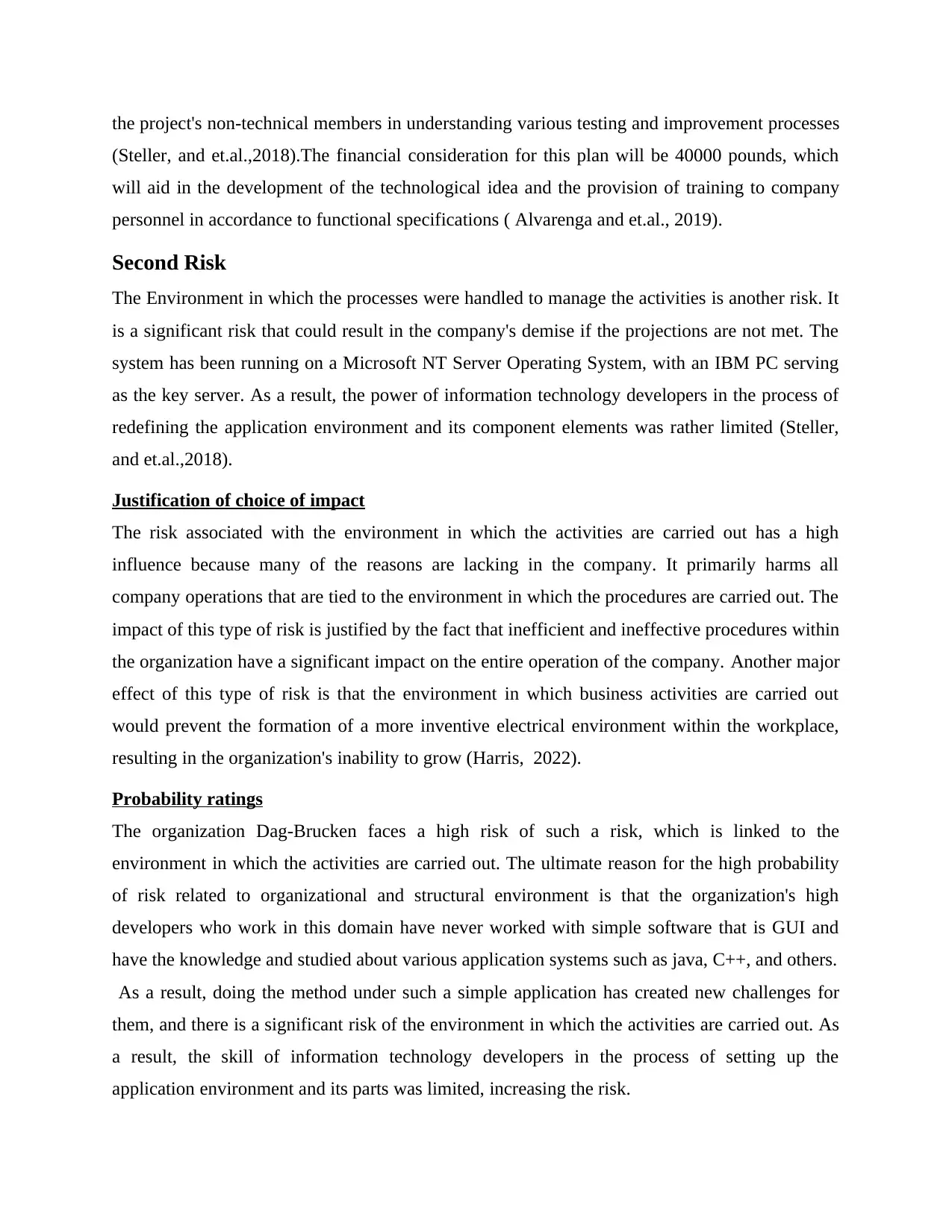
the project's non-technical members in understanding various testing and improvement processes
(Steller, and et.al.,2018).The financial consideration for this plan will be 40000 pounds, which
will aid in the development of the technological idea and the provision of training to company
personnel in accordance to functional specifications ( Alvarenga and et.al., 2019).
Second Risk
The Environment in which the processes were handled to manage the activities is another risk. It
is a significant risk that could result in the company's demise if the projections are not met. The
system has been running on a Microsoft NT Server Operating System, with an IBM PC serving
as the key server. As a result, the power of information technology developers in the process of
redefining the application environment and its component elements was rather limited (Steller,
and et.al.,2018).
Justification of choice of impact
The risk associated with the environment in which the activities are carried out has a high
influence because many of the reasons are lacking in the company. It primarily harms all
company operations that are tied to the environment in which the procedures are carried out. The
impact of this type of risk is justified by the fact that inefficient and ineffective procedures within
the organization have a significant impact on the entire operation of the company. Another major
effect of this type of risk is that the environment in which business activities are carried out
would prevent the formation of a more inventive electrical environment within the workplace,
resulting in the organization's inability to grow (Harris, 2022).
Probability ratings
The organization Dag-Brucken faces a high risk of such a risk, which is linked to the
environment in which the activities are carried out. The ultimate reason for the high probability
of risk related to organizational and structural environment is that the organization's high
developers who work in this domain have never worked with simple software that is GUI and
have the knowledge and studied about various application systems such as java, C++, and others.
As a result, doing the method under such a simple application has created new challenges for
them, and there is a significant risk of the environment in which the activities are carried out. As
a result, the skill of information technology developers in the process of setting up the
application environment and its parts was limited, increasing the risk.
(Steller, and et.al.,2018).The financial consideration for this plan will be 40000 pounds, which
will aid in the development of the technological idea and the provision of training to company
personnel in accordance to functional specifications ( Alvarenga and et.al., 2019).
Second Risk
The Environment in which the processes were handled to manage the activities is another risk. It
is a significant risk that could result in the company's demise if the projections are not met. The
system has been running on a Microsoft NT Server Operating System, with an IBM PC serving
as the key server. As a result, the power of information technology developers in the process of
redefining the application environment and its component elements was rather limited (Steller,
and et.al.,2018).
Justification of choice of impact
The risk associated with the environment in which the activities are carried out has a high
influence because many of the reasons are lacking in the company. It primarily harms all
company operations that are tied to the environment in which the procedures are carried out. The
impact of this type of risk is justified by the fact that inefficient and ineffective procedures within
the organization have a significant impact on the entire operation of the company. Another major
effect of this type of risk is that the environment in which business activities are carried out
would prevent the formation of a more inventive electrical environment within the workplace,
resulting in the organization's inability to grow (Harris, 2022).
Probability ratings
The organization Dag-Brucken faces a high risk of such a risk, which is linked to the
environment in which the activities are carried out. The ultimate reason for the high probability
of risk related to organizational and structural environment is that the organization's high
developers who work in this domain have never worked with simple software that is GUI and
have the knowledge and studied about various application systems such as java, C++, and others.
As a result, doing the method under such a simple application has created new challenges for
them, and there is a significant risk of the environment in which the activities are carried out. As
a result, the skill of information technology developers in the process of setting up the
application environment and its parts was limited, increasing the risk.
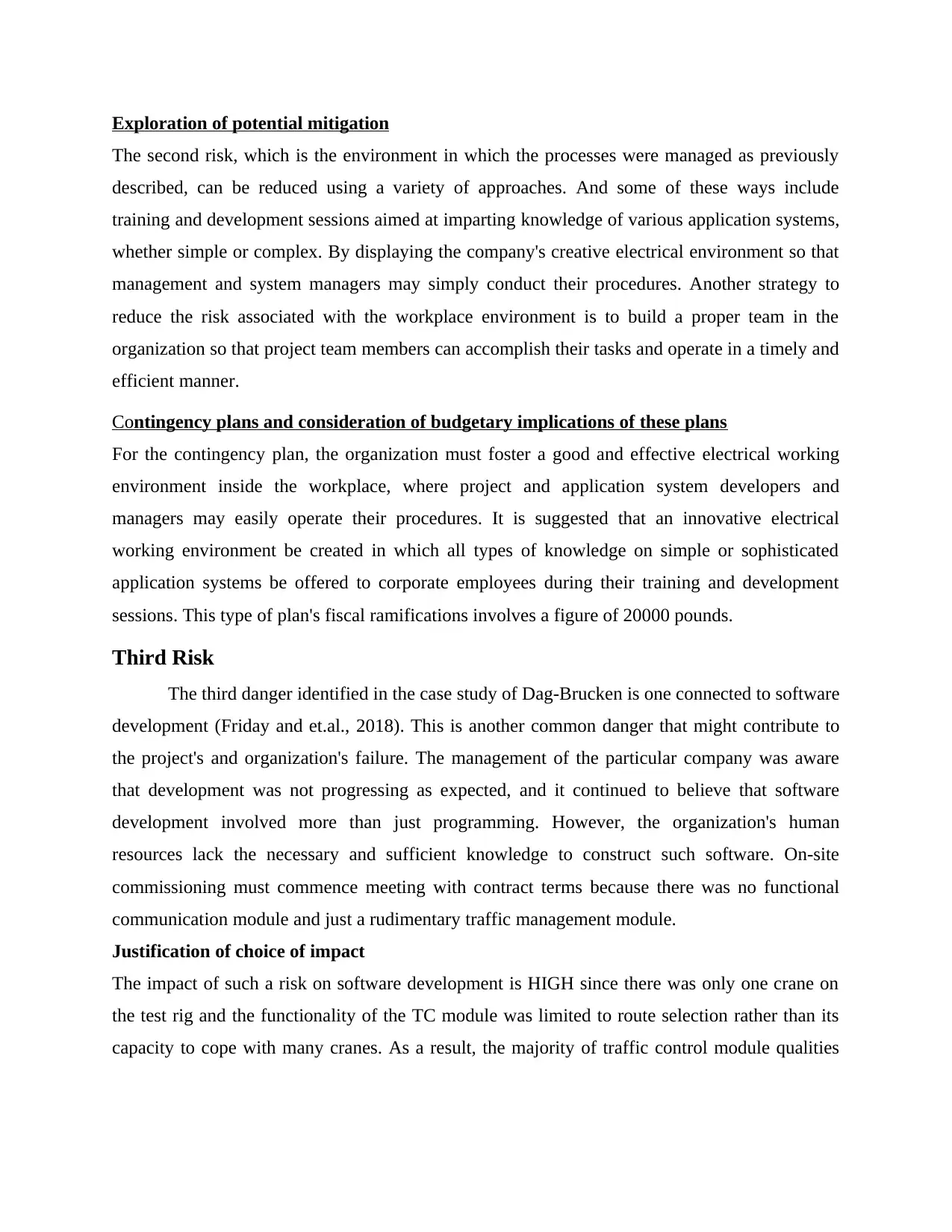
Exploration of potential mitigation
The second risk, which is the environment in which the processes were managed as previously
described, can be reduced using a variety of approaches. And some of these ways include
training and development sessions aimed at imparting knowledge of various application systems,
whether simple or complex. By displaying the company's creative electrical environment so that
management and system managers may simply conduct their procedures. Another strategy to
reduce the risk associated with the workplace environment is to build a proper team in the
organization so that project team members can accomplish their tasks and operate in a timely and
efficient manner.
Contingency plans and consideration of budgetary implications of these plans
For the contingency plan, the organization must foster a good and effective electrical working
environment inside the workplace, where project and application system developers and
managers may easily operate their procedures. It is suggested that an innovative electrical
working environment be created in which all types of knowledge on simple or sophisticated
application systems be offered to corporate employees during their training and development
sessions. This type of plan's fiscal ramifications involves a figure of 20000 pounds.
Third Risk
The third danger identified in the case study of Dag-Brucken is one connected to software
development (Friday and et.al., 2018). This is another common danger that might contribute to
the project's and organization's failure. The management of the particular company was aware
that development was not progressing as expected, and it continued to believe that software
development involved more than just programming. However, the organization's human
resources lack the necessary and sufficient knowledge to construct such software. On-site
commissioning must commence meeting with contract terms because there was no functional
communication module and just a rudimentary traffic management module.
Justification of choice of impact
The impact of such a risk on software development is HIGH since there was only one crane on
the test rig and the functionality of the TC module was limited to route selection rather than its
capacity to cope with many cranes. As a result, the majority of traffic control module qualities
The second risk, which is the environment in which the processes were managed as previously
described, can be reduced using a variety of approaches. And some of these ways include
training and development sessions aimed at imparting knowledge of various application systems,
whether simple or complex. By displaying the company's creative electrical environment so that
management and system managers may simply conduct their procedures. Another strategy to
reduce the risk associated with the workplace environment is to build a proper team in the
organization so that project team members can accomplish their tasks and operate in a timely and
efficient manner.
Contingency plans and consideration of budgetary implications of these plans
For the contingency plan, the organization must foster a good and effective electrical working
environment inside the workplace, where project and application system developers and
managers may easily operate their procedures. It is suggested that an innovative electrical
working environment be created in which all types of knowledge on simple or sophisticated
application systems be offered to corporate employees during their training and development
sessions. This type of plan's fiscal ramifications involves a figure of 20000 pounds.
Third Risk
The third danger identified in the case study of Dag-Brucken is one connected to software
development (Friday and et.al., 2018). This is another common danger that might contribute to
the project's and organization's failure. The management of the particular company was aware
that development was not progressing as expected, and it continued to believe that software
development involved more than just programming. However, the organization's human
resources lack the necessary and sufficient knowledge to construct such software. On-site
commissioning must commence meeting with contract terms because there was no functional
communication module and just a rudimentary traffic management module.
Justification of choice of impact
The impact of such a risk on software development is HIGH since there was only one crane on
the test rig and the functionality of the TC module was limited to route selection rather than its
capacity to cope with many cranes. As a result, the majority of traffic control module qualities
⊘ This is a preview!⊘
Do you want full access?
Subscribe today to unlock all pages.

Trusted by 1+ million students worldwide
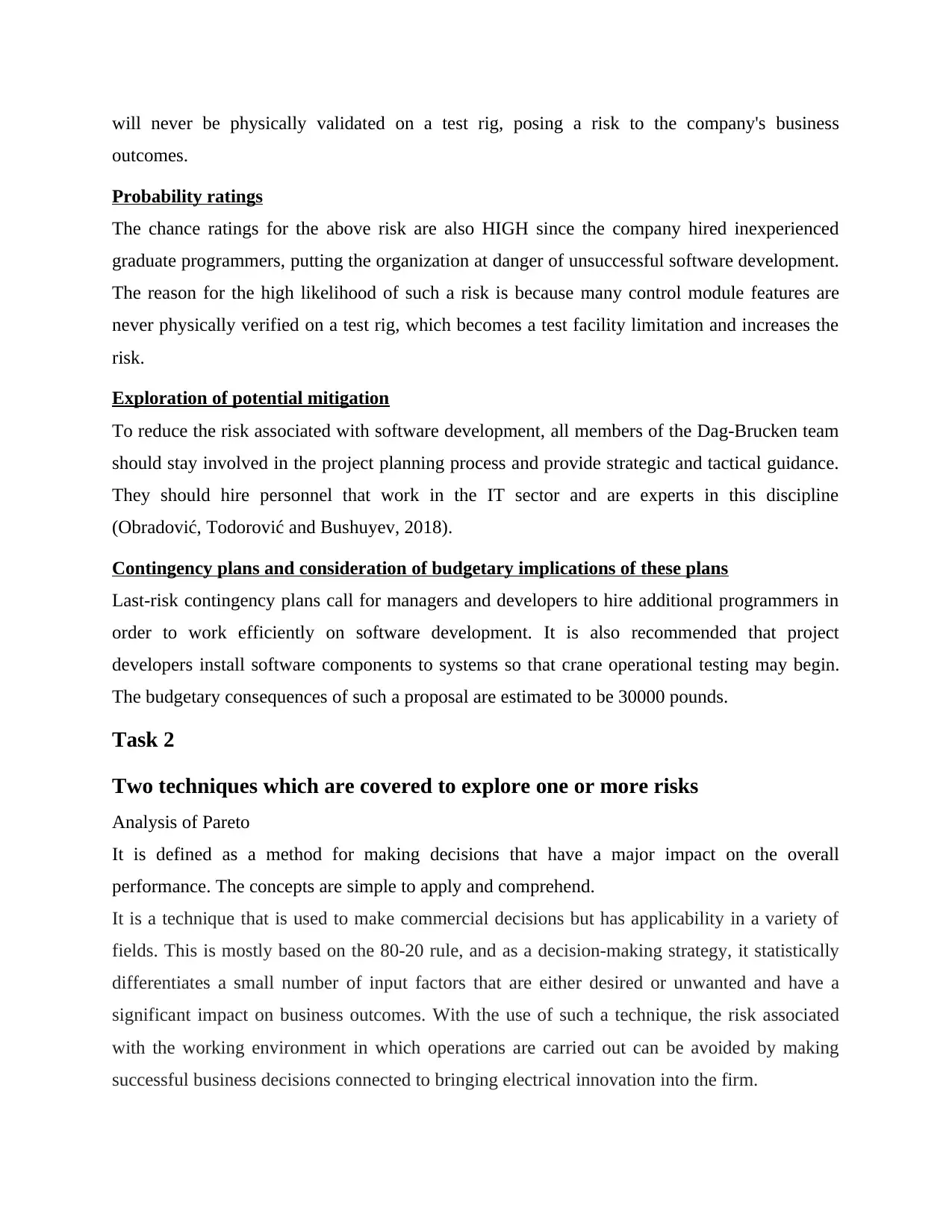
will never be physically validated on a test rig, posing a risk to the company's business
outcomes.
Probability ratings
The chance ratings for the above risk are also HIGH since the company hired inexperienced
graduate programmers, putting the organization at danger of unsuccessful software development.
The reason for the high likelihood of such a risk is because many control module features are
never physically verified on a test rig, which becomes a test facility limitation and increases the
risk.
Exploration of potential mitigation
To reduce the risk associated with software development, all members of the Dag-Brucken team
should stay involved in the project planning process and provide strategic and tactical guidance.
They should hire personnel that work in the IT sector and are experts in this discipline
(Obradović, Todorović and Bushuyev, 2018).
Contingency plans and consideration of budgetary implications of these plans
Last-risk contingency plans call for managers and developers to hire additional programmers in
order to work efficiently on software development. It is also recommended that project
developers install software components to systems so that crane operational testing may begin.
The budgetary consequences of such a proposal are estimated to be 30000 pounds.
Task 2
Two techniques which are covered to explore one or more risks
Analysis of Pareto
It is defined as a method for making decisions that have a major impact on the overall
performance. The concepts are simple to apply and comprehend.
It is a technique that is used to make commercial decisions but has applicability in a variety of
fields. This is mostly based on the 80-20 rule, and as a decision-making strategy, it statistically
differentiates a small number of input factors that are either desired or unwanted and have a
significant impact on business outcomes. With the use of such a technique, the risk associated
with the working environment in which operations are carried out can be avoided by making
successful business decisions connected to bringing electrical innovation into the firm.
outcomes.
Probability ratings
The chance ratings for the above risk are also HIGH since the company hired inexperienced
graduate programmers, putting the organization at danger of unsuccessful software development.
The reason for the high likelihood of such a risk is because many control module features are
never physically verified on a test rig, which becomes a test facility limitation and increases the
risk.
Exploration of potential mitigation
To reduce the risk associated with software development, all members of the Dag-Brucken team
should stay involved in the project planning process and provide strategic and tactical guidance.
They should hire personnel that work in the IT sector and are experts in this discipline
(Obradović, Todorović and Bushuyev, 2018).
Contingency plans and consideration of budgetary implications of these plans
Last-risk contingency plans call for managers and developers to hire additional programmers in
order to work efficiently on software development. It is also recommended that project
developers install software components to systems so that crane operational testing may begin.
The budgetary consequences of such a proposal are estimated to be 30000 pounds.
Task 2
Two techniques which are covered to explore one or more risks
Analysis of Pareto
It is defined as a method for making decisions that have a major impact on the overall
performance. The concepts are simple to apply and comprehend.
It is a technique that is used to make commercial decisions but has applicability in a variety of
fields. This is mostly based on the 80-20 rule, and as a decision-making strategy, it statistically
differentiates a small number of input factors that are either desired or unwanted and have a
significant impact on business outcomes. With the use of such a technique, the risk associated
with the working environment in which operations are carried out can be avoided by making
successful business decisions connected to bringing electrical innovation into the firm.
Paraphrase This Document
Need a fresh take? Get an instant paraphrase of this document with our AI Paraphraser
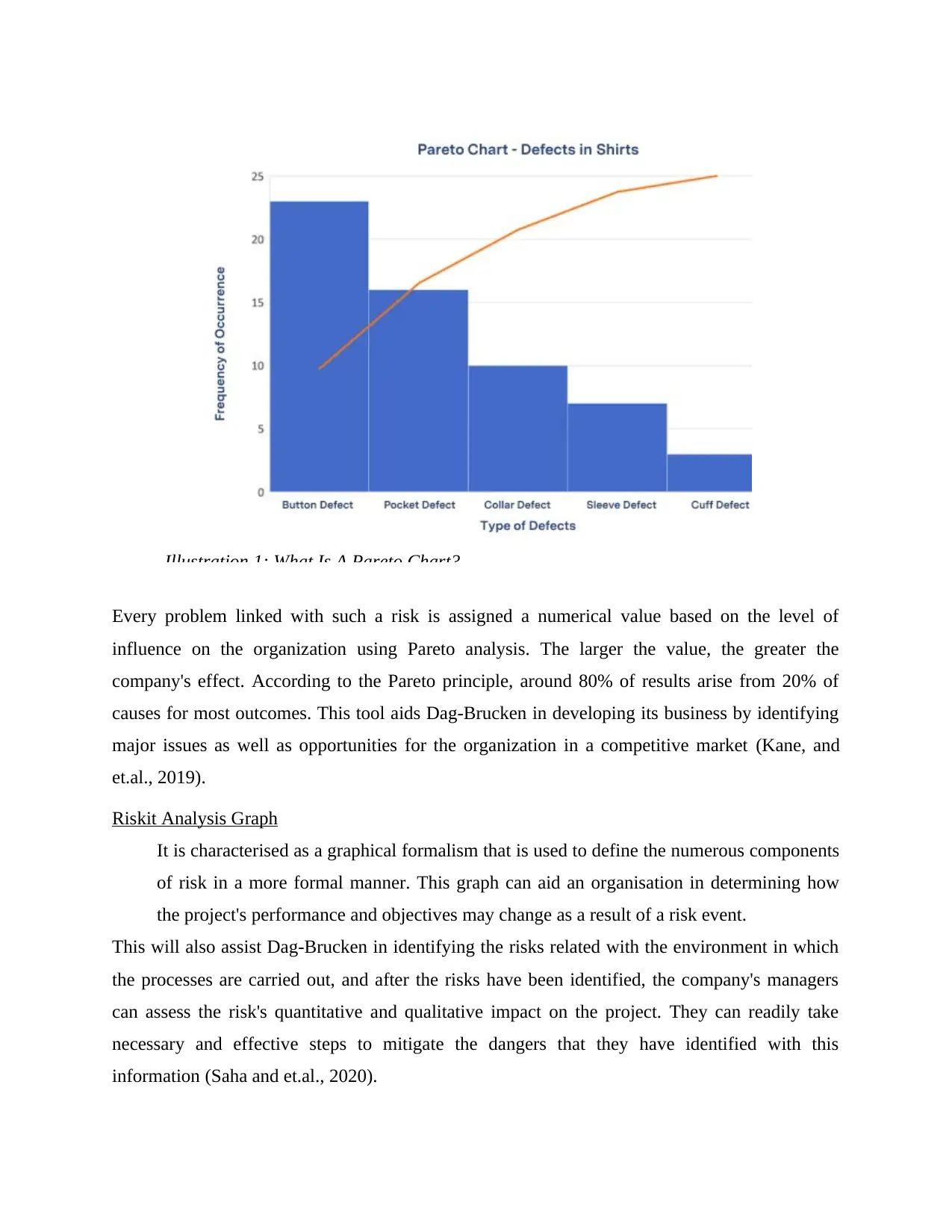
Every problem linked with such a risk is assigned a numerical value based on the level of
influence on the organization using Pareto analysis. The larger the value, the greater the
company's effect. According to the Pareto principle, around 80% of results arise from 20% of
causes for most outcomes. This tool aids Dag-Brucken in developing its business by identifying
major issues as well as opportunities for the organization in a competitive market (Kane, and
et.al., 2019).
Riskit Analysis Graph
It is characterised as a graphical formalism that is used to define the numerous components
of risk in a more formal manner. This graph can aid an organisation in determining how
the project's performance and objectives may change as a result of a risk event.
This will also assist Dag-Brucken in identifying the risks related with the environment in which
the processes are carried out, and after the risks have been identified, the company's managers
can assess the risk's quantitative and qualitative impact on the project. They can readily take
necessary and effective steps to mitigate the dangers that they have identified with this
information (Saha and et.al., 2020).
Illustration 1: What Is A Pareto Chart?
influence on the organization using Pareto analysis. The larger the value, the greater the
company's effect. According to the Pareto principle, around 80% of results arise from 20% of
causes for most outcomes. This tool aids Dag-Brucken in developing its business by identifying
major issues as well as opportunities for the organization in a competitive market (Kane, and
et.al., 2019).
Riskit Analysis Graph
It is characterised as a graphical formalism that is used to define the numerous components
of risk in a more formal manner. This graph can aid an organisation in determining how
the project's performance and objectives may change as a result of a risk event.
This will also assist Dag-Brucken in identifying the risks related with the environment in which
the processes are carried out, and after the risks have been identified, the company's managers
can assess the risk's quantitative and qualitative impact on the project. They can readily take
necessary and effective steps to mitigate the dangers that they have identified with this
information (Saha and et.al., 2020).
Illustration 1: What Is A Pareto Chart?
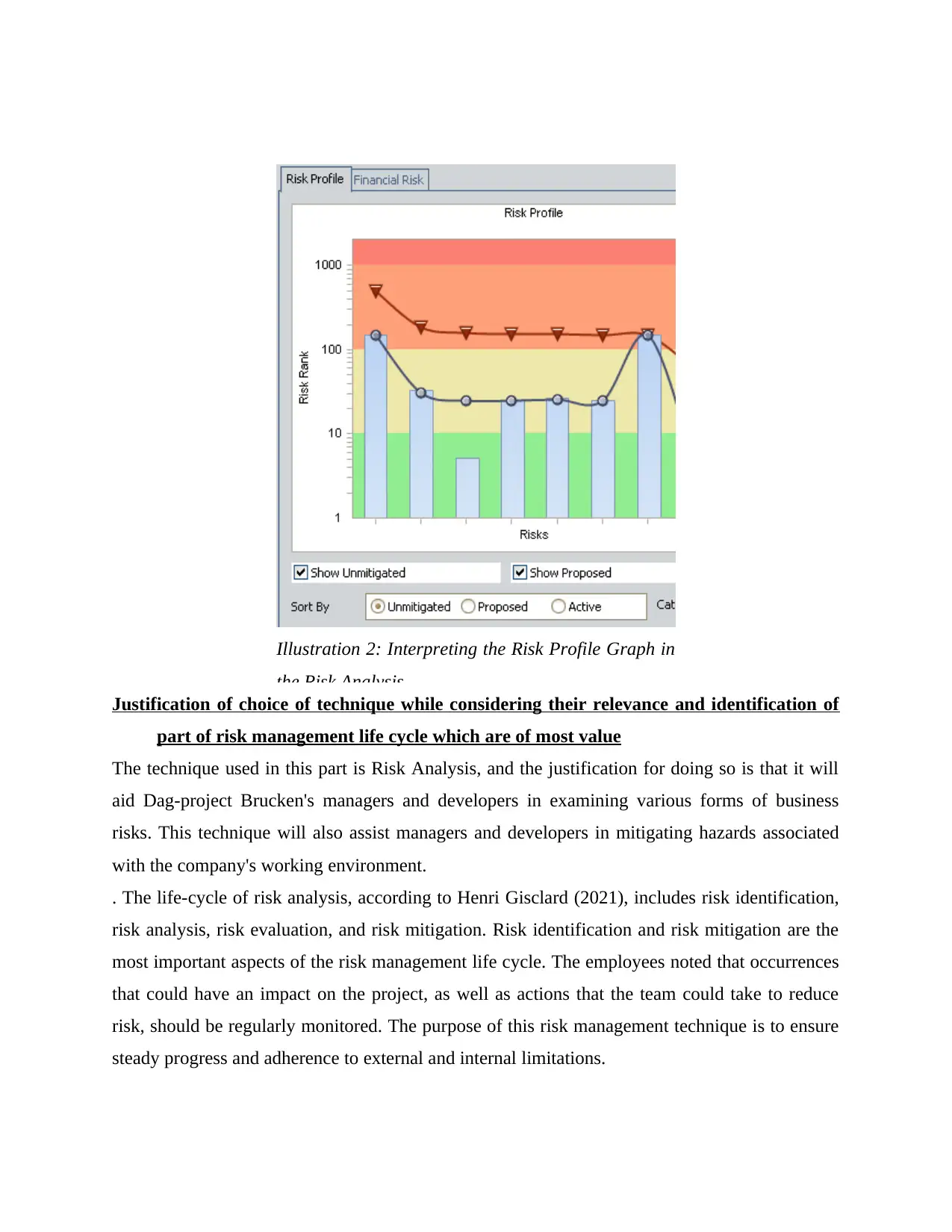
Justification of choice of technique while considering their relevance and identification of
part of risk management life cycle which are of most value
The technique used in this part is Risk Analysis, and the justification for doing so is that it will
aid Dag-project Brucken's managers and developers in examining various forms of business
risks. This technique will also assist managers and developers in mitigating hazards associated
with the company's working environment.
. The life-cycle of risk analysis, according to Henri Gisclard (2021), includes risk identification,
risk analysis, risk evaluation, and risk mitigation. Risk identification and risk mitigation are the
most important aspects of the risk management life cycle. The employees noted that occurrences
that could have an impact on the project, as well as actions that the team could take to reduce
risk, should be regularly monitored. The purpose of this risk management technique is to ensure
steady progress and adherence to external and internal limitations.
Illustration 2: Interpreting the Risk Profile Graph in
the Risk Analysis
part of risk management life cycle which are of most value
The technique used in this part is Risk Analysis, and the justification for doing so is that it will
aid Dag-project Brucken's managers and developers in examining various forms of business
risks. This technique will also assist managers and developers in mitigating hazards associated
with the company's working environment.
. The life-cycle of risk analysis, according to Henri Gisclard (2021), includes risk identification,
risk analysis, risk evaluation, and risk mitigation. Risk identification and risk mitigation are the
most important aspects of the risk management life cycle. The employees noted that occurrences
that could have an impact on the project, as well as actions that the team could take to reduce
risk, should be regularly monitored. The purpose of this risk management technique is to ensure
steady progress and adherence to external and internal limitations.
Illustration 2: Interpreting the Risk Profile Graph in
the Risk Analysis
⊘ This is a preview!⊘
Do you want full access?
Subscribe today to unlock all pages.

Trusted by 1+ million students worldwide
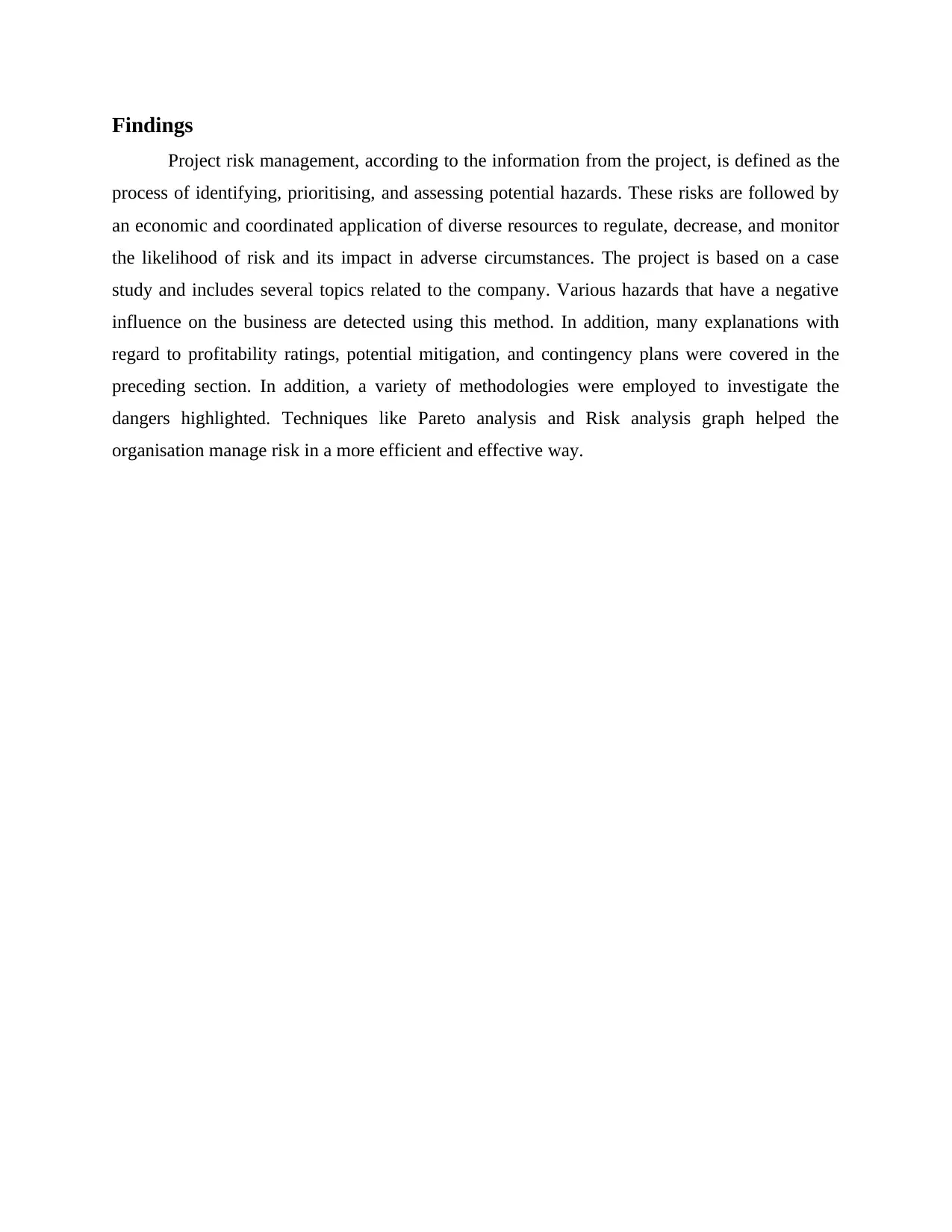
Findings
Project risk management, according to the information from the project, is defined as the
process of identifying, prioritising, and assessing potential hazards. These risks are followed by
an economic and coordinated application of diverse resources to regulate, decrease, and monitor
the likelihood of risk and its impact in adverse circumstances. The project is based on a case
study and includes several topics related to the company. Various hazards that have a negative
influence on the business are detected using this method. In addition, many explanations with
regard to profitability ratings, potential mitigation, and contingency plans were covered in the
preceding section. In addition, a variety of methodologies were employed to investigate the
dangers highlighted. Techniques like Pareto analysis and Risk analysis graph helped the
organisation manage risk in a more efficient and effective way.
Project risk management, according to the information from the project, is defined as the
process of identifying, prioritising, and assessing potential hazards. These risks are followed by
an economic and coordinated application of diverse resources to regulate, decrease, and monitor
the likelihood of risk and its impact in adverse circumstances. The project is based on a case
study and includes several topics related to the company. Various hazards that have a negative
influence on the business are detected using this method. In addition, many explanations with
regard to profitability ratings, potential mitigation, and contingency plans were covered in the
preceding section. In addition, a variety of methodologies were employed to investigate the
dangers highlighted. Techniques like Pareto analysis and Risk analysis graph helped the
organisation manage risk in a more efficient and effective way.
Paraphrase This Document
Need a fresh take? Get an instant paraphrase of this document with our AI Paraphraser
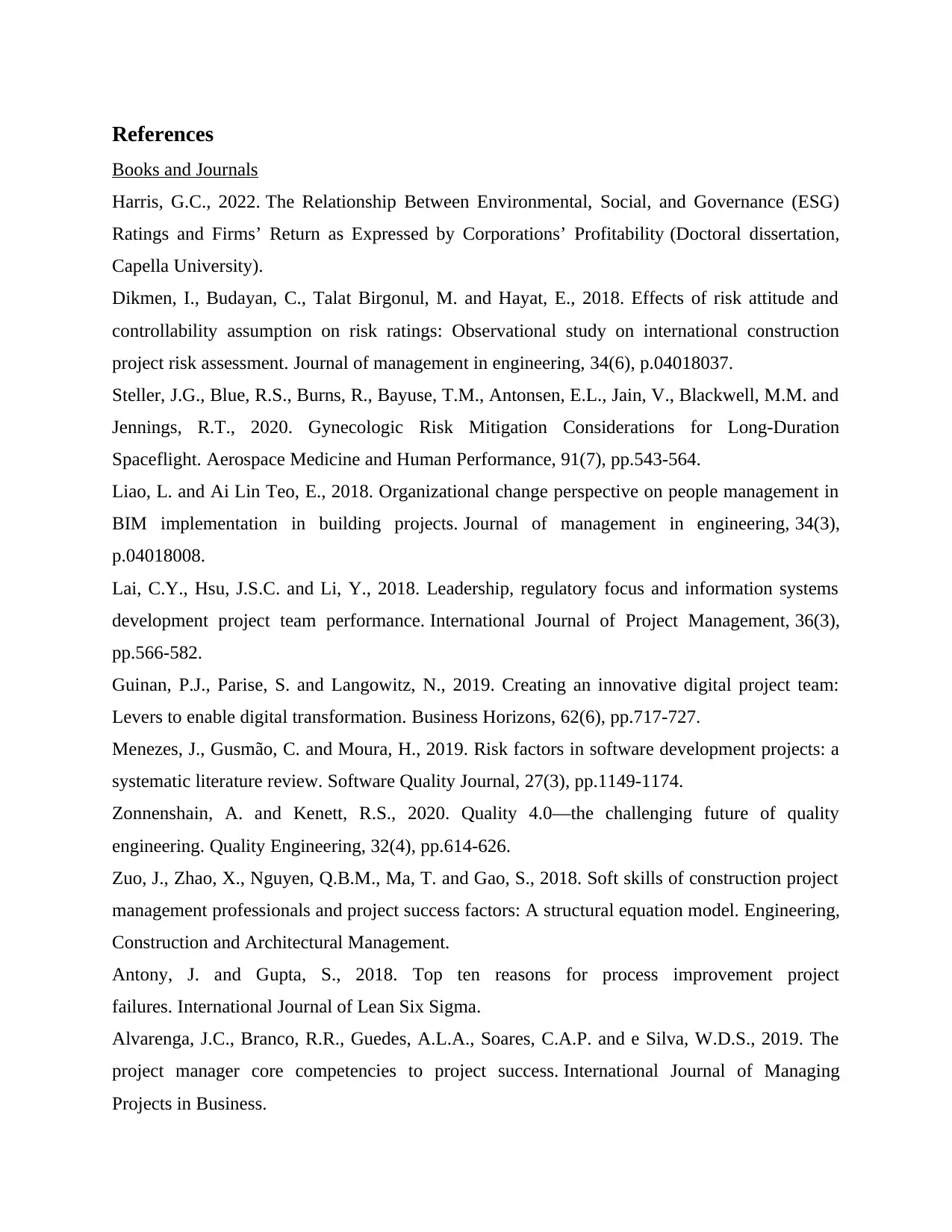
References
Books and Journals
Harris, G.C., 2022. The Relationship Between Environmental, Social, and Governance (ESG)
Ratings and Firms’ Return as Expressed by Corporations’ Profitability (Doctoral dissertation,
Capella University).
Dikmen, I., Budayan, C., Talat Birgonul, M. and Hayat, E., 2018. Effects of risk attitude and
controllability assumption on risk ratings: Observational study on international construction
project risk assessment. Journal of management in engineering, 34(6), p.04018037.
Steller, J.G., Blue, R.S., Burns, R., Bayuse, T.M., Antonsen, E.L., Jain, V., Blackwell, M.M. and
Jennings, R.T., 2020. Gynecologic Risk Mitigation Considerations for Long-Duration
Spaceflight. Aerospace Medicine and Human Performance, 91(7), pp.543-564.
Liao, L. and Ai Lin Teo, E., 2018. Organizational change perspective on people management in
BIM implementation in building projects. Journal of management in engineering, 34(3),
p.04018008.
Lai, C.Y., Hsu, J.S.C. and Li, Y., 2018. Leadership, regulatory focus and information systems
development project team performance. International Journal of Project Management, 36(3),
pp.566-582.
Guinan, P.J., Parise, S. and Langowitz, N., 2019. Creating an innovative digital project team:
Levers to enable digital transformation. Business Horizons, 62(6), pp.717-727.
Menezes, J., Gusmão, C. and Moura, H., 2019. Risk factors in software development projects: a
systematic literature review. Software Quality Journal, 27(3), pp.1149-1174.
Zonnenshain, A. and Kenett, R.S., 2020. Quality 4.0—the challenging future of quality
engineering. Quality Engineering, 32(4), pp.614-626.
Zuo, J., Zhao, X., Nguyen, Q.B.M., Ma, T. and Gao, S., 2018. Soft skills of construction project
management professionals and project success factors: A structural equation model. Engineering,
Construction and Architectural Management.
Antony, J. and Gupta, S., 2018. Top ten reasons for process improvement project
failures. International Journal of Lean Six Sigma.
Alvarenga, J.C., Branco, R.R., Guedes, A.L.A., Soares, C.A.P. and e Silva, W.D.S., 2019. The
project manager core competencies to project success. International Journal of Managing
Projects in Business.
Books and Journals
Harris, G.C., 2022. The Relationship Between Environmental, Social, and Governance (ESG)
Ratings and Firms’ Return as Expressed by Corporations’ Profitability (Doctoral dissertation,
Capella University).
Dikmen, I., Budayan, C., Talat Birgonul, M. and Hayat, E., 2018. Effects of risk attitude and
controllability assumption on risk ratings: Observational study on international construction
project risk assessment. Journal of management in engineering, 34(6), p.04018037.
Steller, J.G., Blue, R.S., Burns, R., Bayuse, T.M., Antonsen, E.L., Jain, V., Blackwell, M.M. and
Jennings, R.T., 2020. Gynecologic Risk Mitigation Considerations for Long-Duration
Spaceflight. Aerospace Medicine and Human Performance, 91(7), pp.543-564.
Liao, L. and Ai Lin Teo, E., 2018. Organizational change perspective on people management in
BIM implementation in building projects. Journal of management in engineering, 34(3),
p.04018008.
Lai, C.Y., Hsu, J.S.C. and Li, Y., 2018. Leadership, regulatory focus and information systems
development project team performance. International Journal of Project Management, 36(3),
pp.566-582.
Guinan, P.J., Parise, S. and Langowitz, N., 2019. Creating an innovative digital project team:
Levers to enable digital transformation. Business Horizons, 62(6), pp.717-727.
Menezes, J., Gusmão, C. and Moura, H., 2019. Risk factors in software development projects: a
systematic literature review. Software Quality Journal, 27(3), pp.1149-1174.
Zonnenshain, A. and Kenett, R.S., 2020. Quality 4.0—the challenging future of quality
engineering. Quality Engineering, 32(4), pp.614-626.
Zuo, J., Zhao, X., Nguyen, Q.B.M., Ma, T. and Gao, S., 2018. Soft skills of construction project
management professionals and project success factors: A structural equation model. Engineering,
Construction and Architectural Management.
Antony, J. and Gupta, S., 2018. Top ten reasons for process improvement project
failures. International Journal of Lean Six Sigma.
Alvarenga, J.C., Branco, R.R., Guedes, A.L.A., Soares, C.A.P. and e Silva, W.D.S., 2019. The
project manager core competencies to project success. International Journal of Managing
Projects in Business.
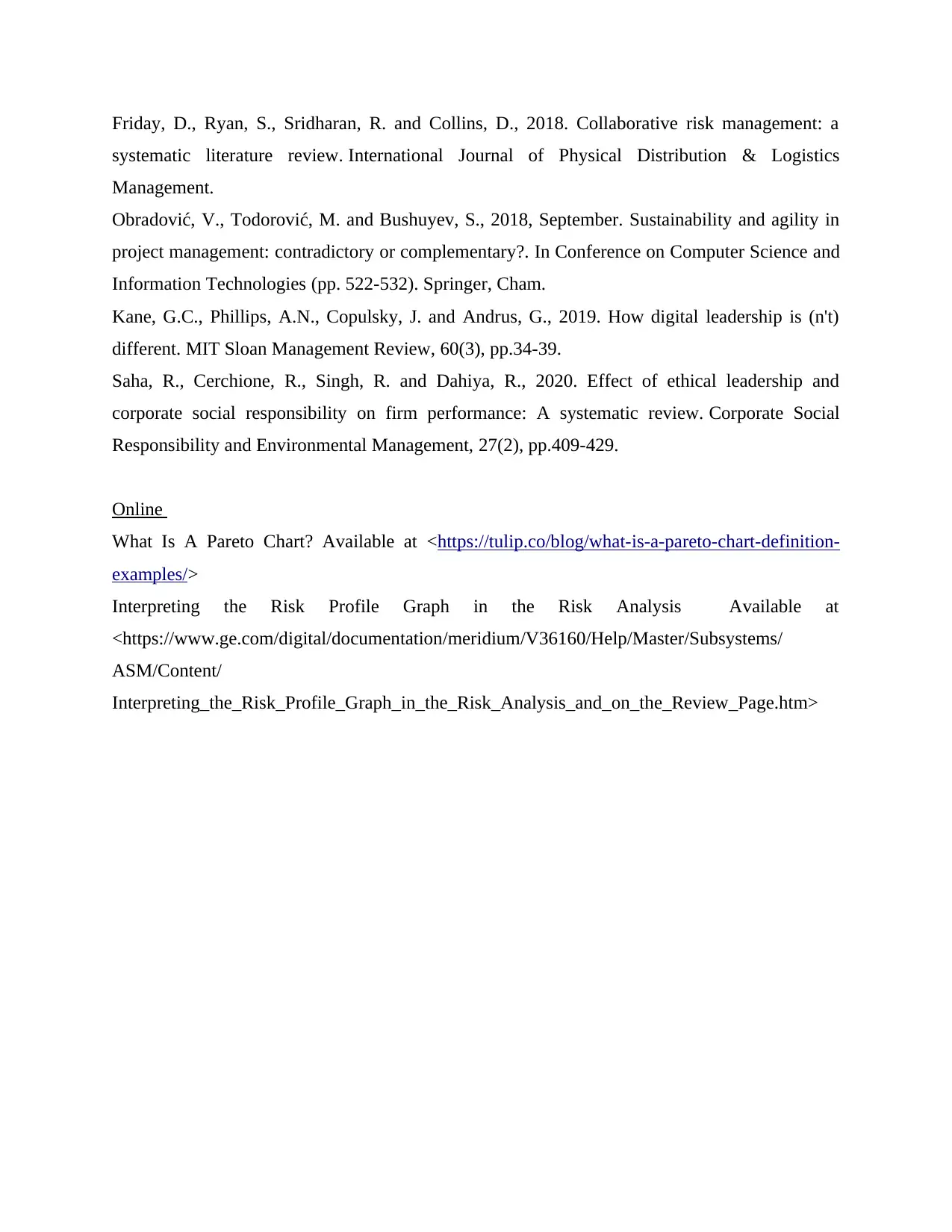
Friday, D., Ryan, S., Sridharan, R. and Collins, D., 2018. Collaborative risk management: a
systematic literature review. International Journal of Physical Distribution & Logistics
Management.
Obradović, V., Todorović, M. and Bushuyev, S., 2018, September. Sustainability and agility in
project management: contradictory or complementary?. In Conference on Computer Science and
Information Technologies (pp. 522-532). Springer, Cham.
Kane, G.C., Phillips, A.N., Copulsky, J. and Andrus, G., 2019. How digital leadership is (n't)
different. MIT Sloan Management Review, 60(3), pp.34-39.
Saha, R., Cerchione, R., Singh, R. and Dahiya, R., 2020. Effect of ethical leadership and
corporate social responsibility on firm performance: A systematic review. Corporate Social
Responsibility and Environmental Management, 27(2), pp.409-429.
Online
What Is A Pareto Chart? Available at <https://tulip.co/blog/what-is-a-pareto-chart-definition-
examples/>
Interpreting the Risk Profile Graph in the Risk Analysis Available at
<https://www.ge.com/digital/documentation/meridium/V36160/Help/Master/Subsystems/
ASM/Content/
Interpreting_the_Risk_Profile_Graph_in_the_Risk_Analysis_and_on_the_Review_Page.htm>
systematic literature review. International Journal of Physical Distribution & Logistics
Management.
Obradović, V., Todorović, M. and Bushuyev, S., 2018, September. Sustainability and agility in
project management: contradictory or complementary?. In Conference on Computer Science and
Information Technologies (pp. 522-532). Springer, Cham.
Kane, G.C., Phillips, A.N., Copulsky, J. and Andrus, G., 2019. How digital leadership is (n't)
different. MIT Sloan Management Review, 60(3), pp.34-39.
Saha, R., Cerchione, R., Singh, R. and Dahiya, R., 2020. Effect of ethical leadership and
corporate social responsibility on firm performance: A systematic review. Corporate Social
Responsibility and Environmental Management, 27(2), pp.409-429.
Online
What Is A Pareto Chart? Available at <https://tulip.co/blog/what-is-a-pareto-chart-definition-
examples/>
Interpreting the Risk Profile Graph in the Risk Analysis Available at
<https://www.ge.com/digital/documentation/meridium/V36160/Help/Master/Subsystems/
ASM/Content/
Interpreting_the_Risk_Profile_Graph_in_the_Risk_Analysis_and_on_the_Review_Page.htm>
⊘ This is a preview!⊘
Do you want full access?
Subscribe today to unlock all pages.

Trusted by 1+ million students worldwide
1 out of 13
Related Documents
Your All-in-One AI-Powered Toolkit for Academic Success.
+13062052269
info@desklib.com
Available 24*7 on WhatsApp / Email
![[object Object]](/_next/static/media/star-bottom.7253800d.svg)
Unlock your academic potential
Copyright © 2020–2025 A2Z Services. All Rights Reserved. Developed and managed by ZUCOL.




